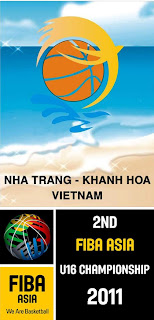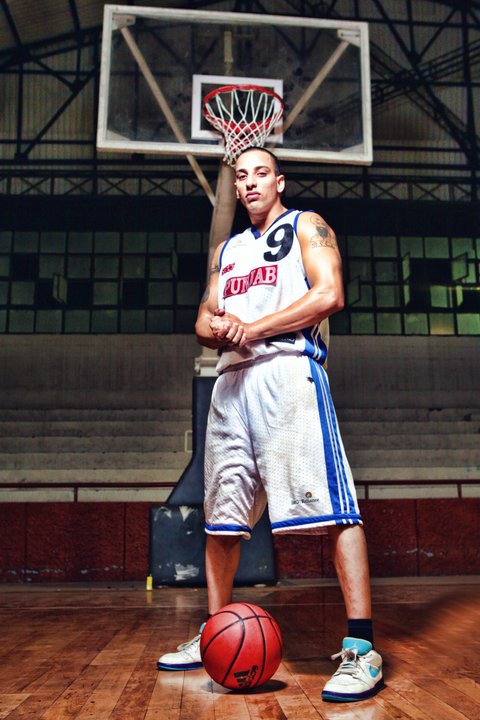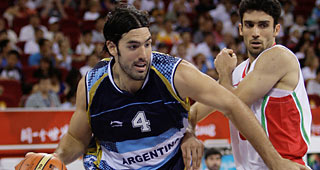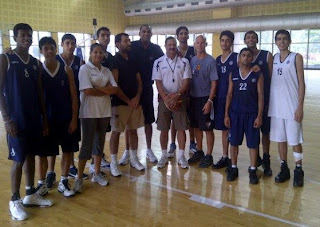If you follow (or want to follow) basketball in India, there is no better time to start paying attention than now: The Indian Men's team has qualified for the 26th FIBA Asia Basketball Championship (ABC), which will be held in Wuhan, China, from September 15-25. This is the biggest basketball tournament for Indian Basketball, featuring 16 of the continent's finest basketball teams (out of 44 federations).

The prize? The winner of the tournament automatically qualifies for the 2012 Olympic Games basketball tournament in London, while the top three teams will qualify for the 2014 FIBA World Championship, featuring the best basketball teams on the planet.
This would be India's 22nd time taking part in this biennial tournament, and no, we haven't had too much success here in the past. Our best finish was a fourth place in Thailand in 1975. We haven't finished in the top eight since 2003. Most recently, at the 25th FIBA ABC in Tianjin, China, in 2009, we finished at 13th place.
In the 2009 championship, Iran beat China in the final to win the gold medal.

I don't believe in false optimism, but this year, there is at least a glimmer of hope that, no matter the result, our Young Cagers from India will be causing some of their more favoured rivals some headaches on court. The reason, mostly, is
coach Kenny Natt, formerly an NBA head coach, and a man on a mission to adhere the same tactics with players on the Indian National side that he did with hall of fame basketball players whom he has worked with in the NBA. Now, be assured, Natt has no magic stick to suddenly improve India's fitness, shooting ability, athleticism, mental strength, and all the other background crap ailing sports in the country: We have to have patience as things will improve slowly. What Natt does bring is a sense of professionalism, experience, and respect to the team. It will be interesting to see how they respond to him in this tough championship.
This, of course, isn't Natt's first date in serious international competition with India: two months ago, he led India to three easy
blowout victories over neighbours Sri Lanka and Bangladesh to qualify for the FIBA ABC. Watching those games offered a sense of the shape that India had taken under him, but in Wuhan, you can be rest assured that the competition will be multiple times sterner.
Upon his departure, Natt had said “I expect the Indian team to be competitive every night. We will concentrate on one game at a time. I know that we will be a well prepared squad and I aim that, through our performances, we can earn the respect of our opponents.”

India’s 12-player squad includes 15 year old basketball prodigy, Satnam Singh Bhamara, India’s youngest team member. Satnam, an IMG Reliance Scholar, trains at the IMG Basketball Academy in Florida, USA and made his debut with India’s senior team in the Middle Asia Zone Qualifying Round in July.
India's full squad at this tournament will be: Amrit Pal Singh, Amjyot Singh, Dishant Shah, Hareesh Koroth, Jagdeep Singh Bains, Narender Grewal, Prakash Mishra, Satnam Singh Bhamara, Talwinderjit Singh "TJ" Sahi, Trideep Rai, Vishesh Bhriguvanshi, and Yadwinder Singh.
This squad is slightly different from the one that played in the qualifiers in July: most importantly, India is missing on major veteran presence in starting point guard Sambhaji Kadam and bench swingman Riyazuddin, both who are away because of injury. Kadam will particularly be missed, as he was the best 'pass-first' point guard for the team - but his absence has opened the door for a chance at redemption for
Mr. Air India himself, aka TJ Sahi. In a past shaded by that explosive crossover dribble, dunk competition victories, a solid performance
against Yi Jianlian of China, and unfortunately, a series of on/off court behaviour issues, Sahi has been one of the most paradoxical stars of the Indian game. Luckily, under Natt's eye, he has become a lot more disciplined, and it seems that he will be leading the squad from the front as the team's starting point guard.

So the starting line-up seems to be of Sahi at PG, Vishesh Bhriguvanshi at SG (young, experienced, do-it-all swingman, and my personal favourite player on the Indian side), Trideep Rai (our designated sharp-shooter) as SF, and the Punjabi big men combo of Yadwinder Singh and Jagdeep Singh Bains in the frontcourt. Both Yadwinder and Jagdeep are high-energy players, but at around 6 foot 6, will be both undersized when going against Asia's other behemoths.
This is where the bench comes in: it seems to be the golden age for young big men in India. On the bench, we have 20 year old Amrit Pal Singh (6 foot 10), 19 year old Amjyot Singh (6 foot 9), 19 year old Dishant Shah (6 foot 9), and of course, 15 year old Satnam Singh Bhamara (7 foot 1). What these players have in height, unfortunately, they lack in experience. Only Shah had played senior internationals for India before this year, and while there is a lot of potential in these four big men, none of them are yet mentally strong and physically complete to be starters.
The squad is completed with the hard-working backcourt combo of Prakash Mishra and Hareesh Koroth, and another new-comer into the side, Narender Grewal.

Natt has picked the best available players for this tournament, but beyond the starting five plus Prakash and Koroth, there is a definitive lack of experience which may hurt us.
At the MAZ Qualifiers, India played with impressive aggression on defense which led to easy fast break points, and also displayed some great set offensive plays that helped us get many good open shots. In the blowouts, Natt was also able to experiment with the line-up and balance the minutes out. With tougher teams facing us this time around, I expect a lot more pressure on our starters to out up heroic performances for their country.
Now, on to our opponents: The tournament consists of four groups of four teams each. India, ranked 50th in the FIBA World Rankings, is in Group A at the 2011 FIBA ABC, along with Lebanon (ranked 24th), Malaysia (70), and Korea (31). We will be playing these three teams in order in the Preliminary Round on our first three days of the tournament. Korea is the most historically successful side in our group, having won 2 gold and 11 silvers at the tournament, but Lebanon have had more recent success, as they finished 4th in 2009 over Korea's 7th. Malaysia is a side ranked below us, and although that makes us technically favourites to win, they have known to give us problems in the past.

To qualify from our group and move forward into the Second Round (and thus, hope for a top 12 finish), India need to finish in the top 3 of group A, which means that we need to win at least one of our three games. This seems to be very likely: Malaysia are ranked far below us, and the positive momentum of Natt's team might help us overcome them. Beating either Lebanon or Korea and finishing in the top 2, of course, is a far more ambitious challenge.
The Second Round will consist of two groups of six teams each, and the top three teams in one group will play against the top three teams in the other. If all goes as planned, India will likely play against Iran, Qatar, and Chinese Taipei in this round. These are all better teams than us, but if we can get a miraculous victory somewhere here, we might be able to qualify for the Quarter Finals (and a top 8 finish) - Chinese Taipei is probably the best bet for that miracle, because the two Middle Eastern teams will be too strong for us.
The final round, which will consists of the quarters, semis, and finals, will start on Sep 23rd. If India is knocked out, we will play in Classification games to find our final rank.
I will be hoping for (and predicting) an improvement over last time's rank for India: I think we can definitely move on to the Second Round and thus, at least, ensure a top 12 finish. Even if we don't qualify for the Quarter-Finals after this round, we will have a chance to finish between 9-12th.
So, with hesitant optimism, I await the start of the FIBA Asia Basketball Championship - you can follow the recaps of the game on the
Wuhan 2011 website or a more India-focused recap on the
Basketball Federation of India's website. As much as possible, I will also be posting updates about India's progress on my
Facebook and
Twitter page.
Go India!
 Defending champions China were drawn with fellow East Asian team Chinese Taipei, Middle Asia’s India and SEABA’s Malaysia in Group A for the Preliminary Round of the 2nd FIBA Asia U16 Championship to be held in Nha Trang City in Vietnam from Oct 18-28, 2011.
Defending champions China were drawn with fellow East Asian team Chinese Taipei, Middle Asia’s India and SEABA’s Malaysia in Group A for the Preliminary Round of the 2nd FIBA Asia U16 Championship to be held in Nha Trang City in Vietnam from Oct 18-28, 2011. “It is a great significance that we are conducting this draw for the 2nd FIBA Asia U16 Championship on the final day of the 26th FIBA Asia Championship,” said FIBA Asia president Sheikh Saud bin Ali Al-Thani who presided over the draw proceedings.
“It is a great significance that we are conducting this draw for the 2nd FIBA Asia U16 Championship on the final day of the 26th FIBA Asia Championship,” said FIBA Asia president Sheikh Saud bin Ali Al-Thani who presided over the draw proceedings. India’s U16 side qualified for the championship after defeating Nepal and Sri Lanka in qualifiers in New Delhi in August
India’s U16 side qualified for the championship after defeating Nepal and Sri Lanka in qualifiers in New Delhi in August





















